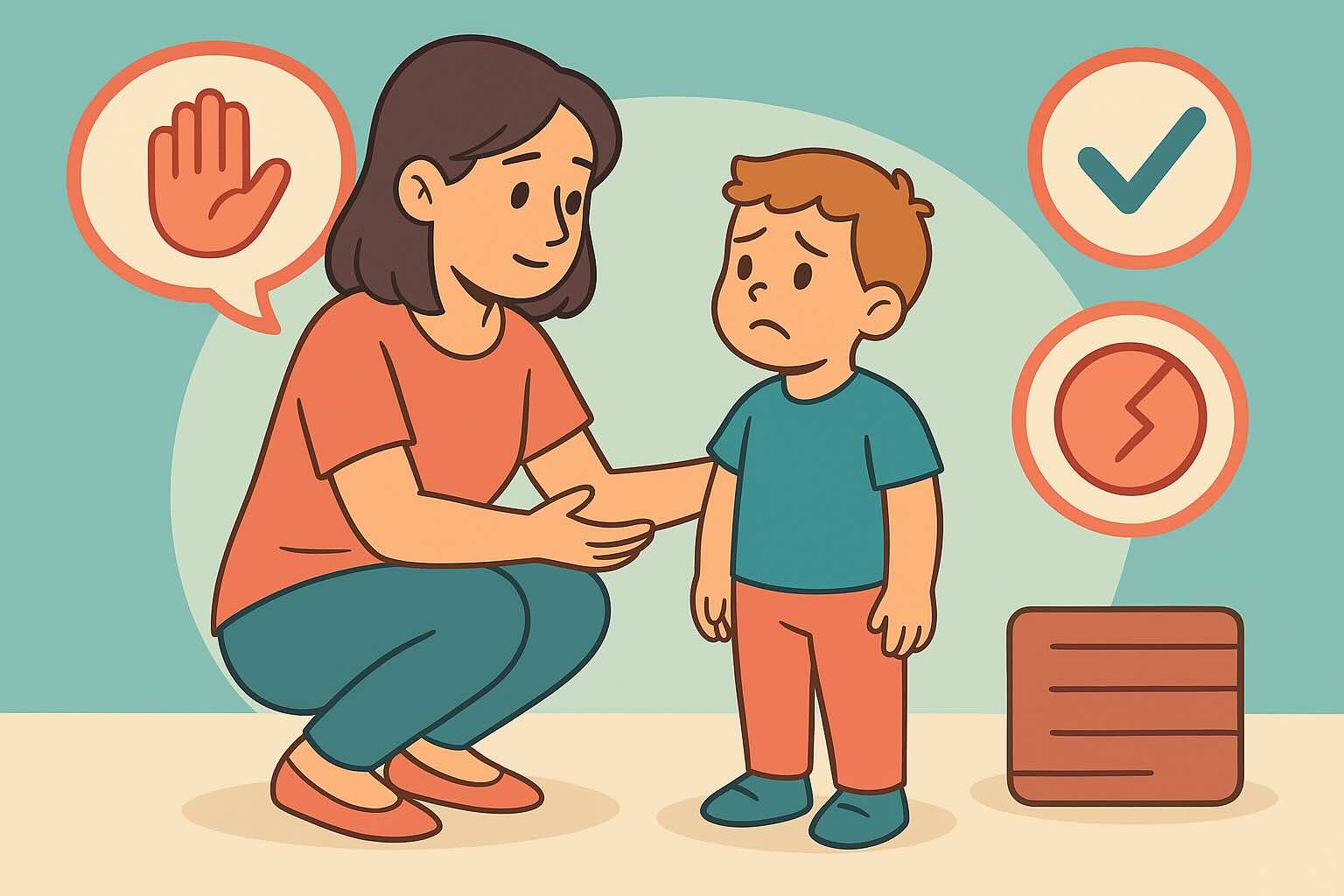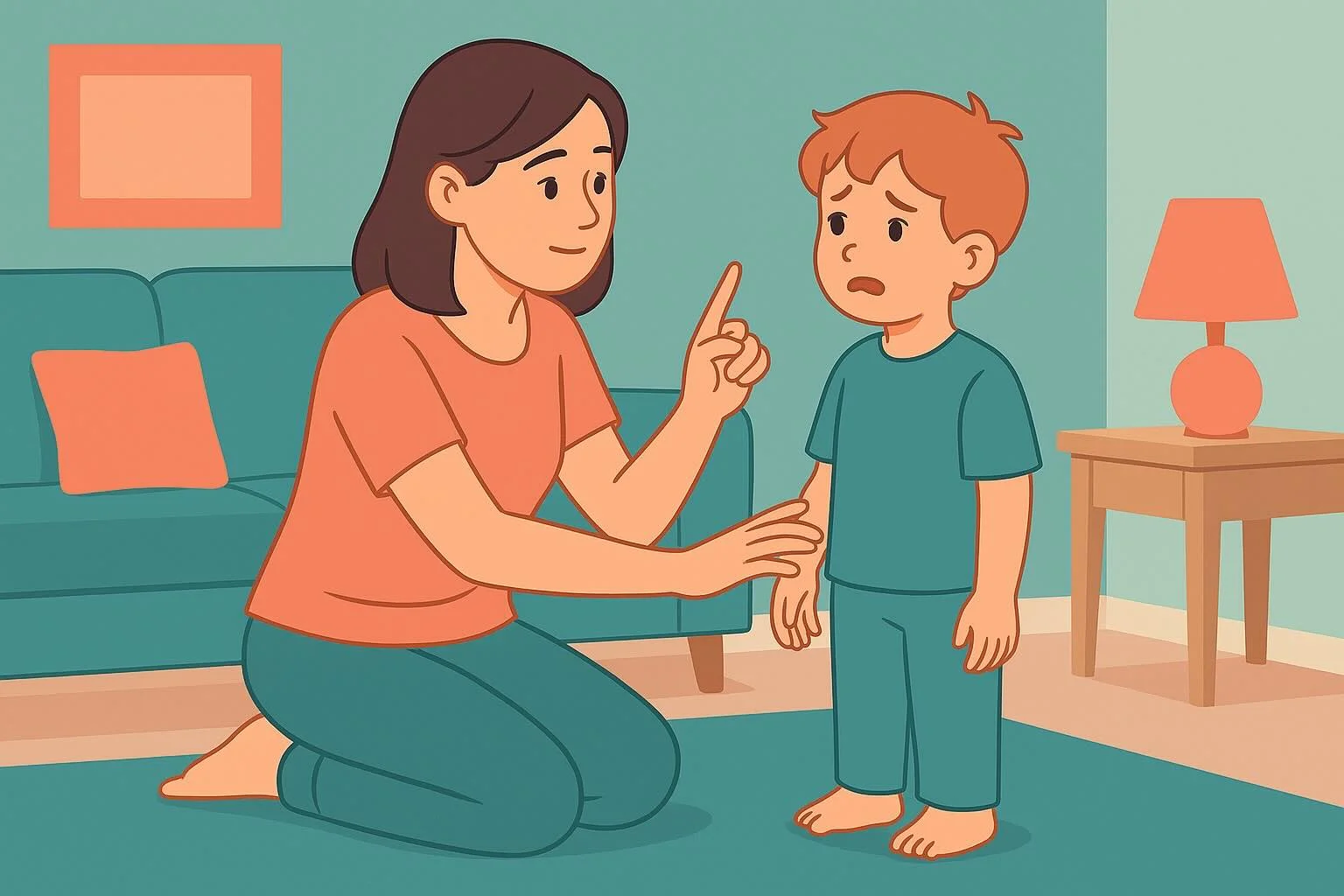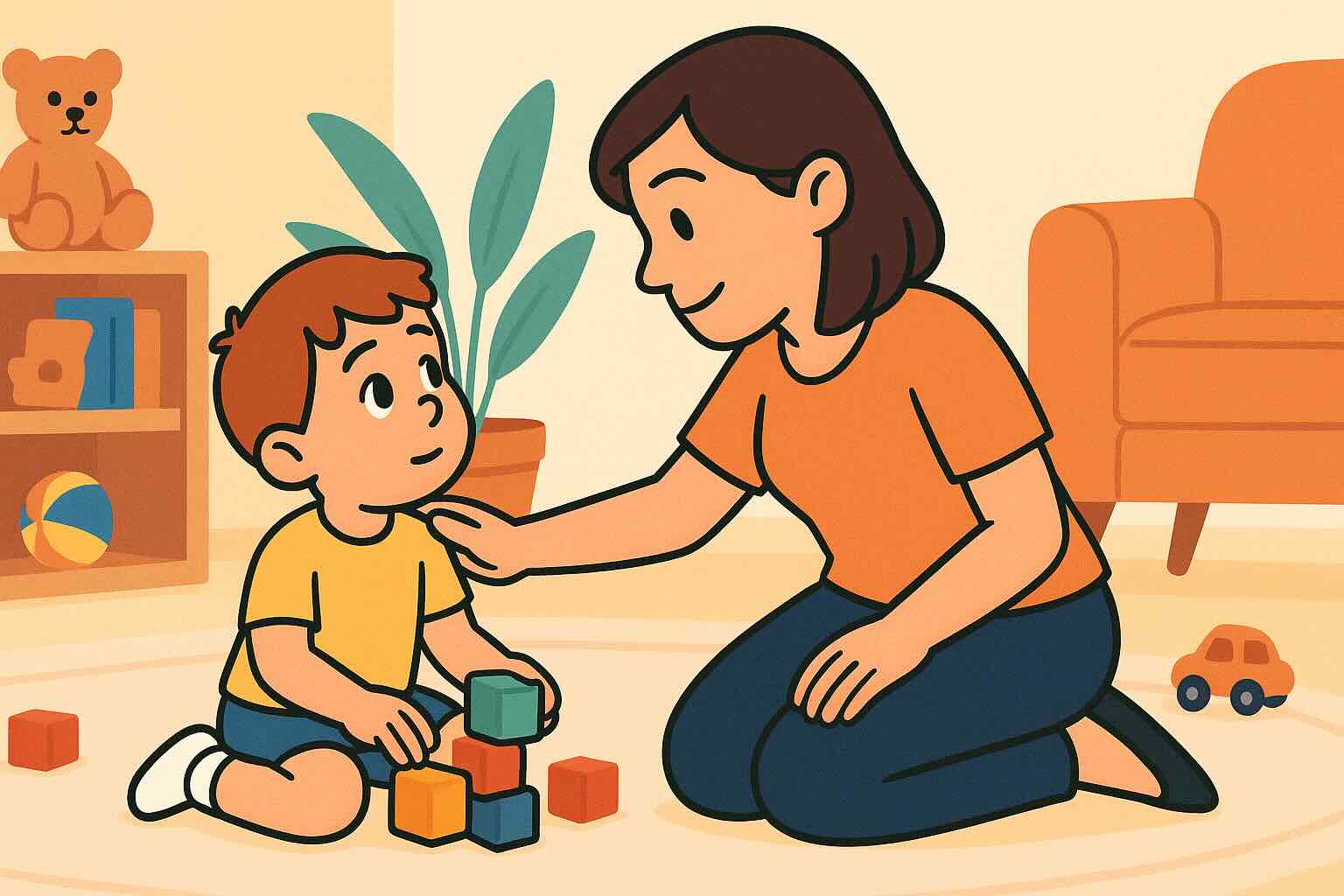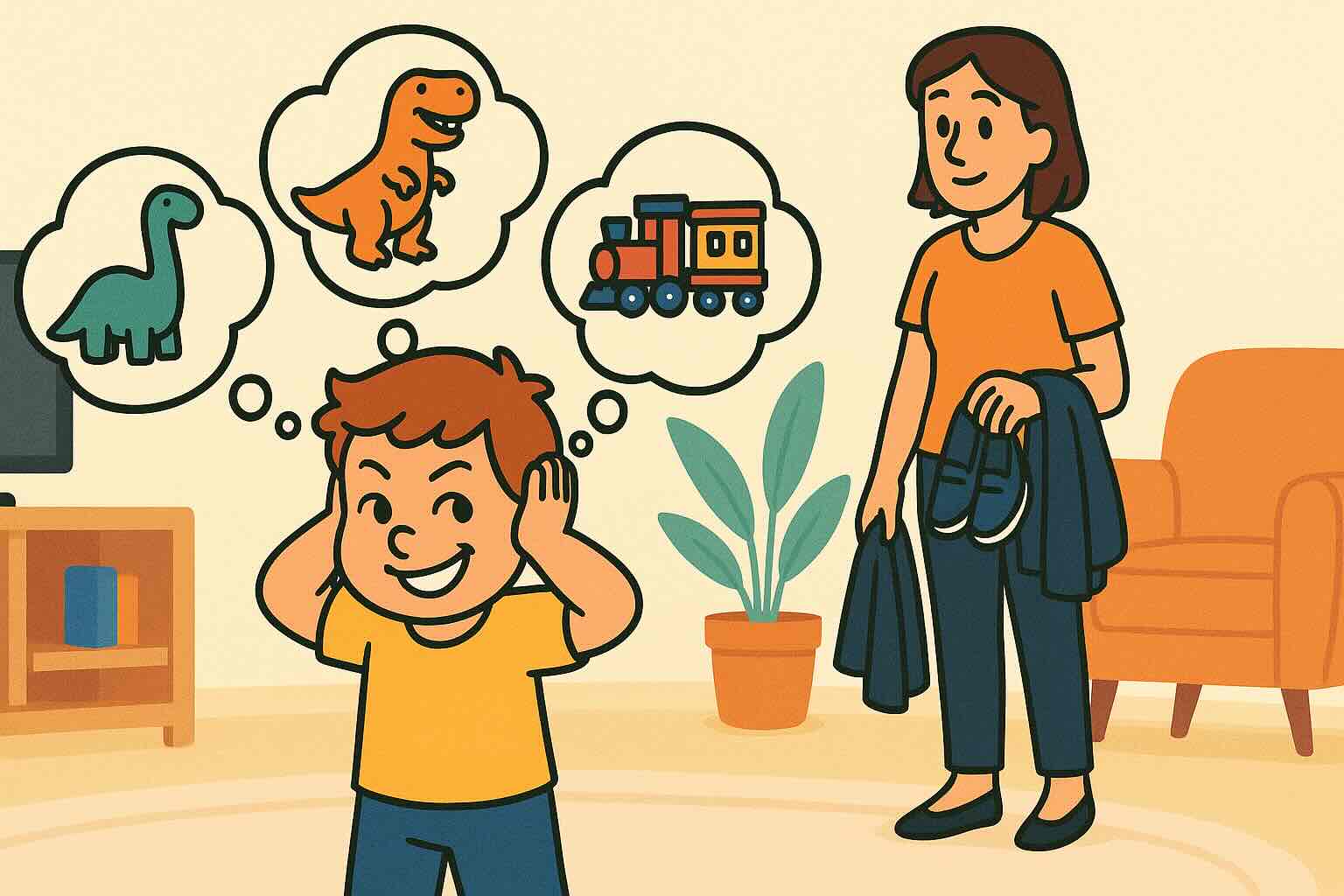Setting Boundaries Without Punishment: 9 Respectful Ways


If you're exhausted from constant battles over bedtime, getting dressed, or cleaning up toys, you're not alone. Many parents believe that effective discipline requires punishments, threats, or harsh consequences. But research in child development shows a more effective path: clear, consistent boundaries combined with connection and natural learning opportunities.
This comprehensive guide will show you how to set boundaries that actually work for children ages 3-7, without relying on punishment, shame, or fear-based tactics that can damage your relationship and your child's emotional development. For families stuck in daily power struggles, our managing power struggles guide shows how to transform conflicts into cooperation using many of these same boundary principles.
What You'll Learn in This Guide
- The Science of Boundaries - Why children actually crave limits and structure
- Boundary vs. Punishment - Understanding the crucial difference that changes everything
- The 4-Step Boundary Framework - Exactly how to set and maintain limits with love
- Age-Specific Strategies - Different approaches for 3-4 year olds vs. 5-7 year olds
- Natural Consequences - How to let learning happen without imposing punishment
- Common Boundary Challenges - Real solutions for the most frequent struggles
- Building Cooperation - How boundaries create connection, not conflict
Estimated reading time: 12 minutes
Why Children Need Boundaries: The Developmental Science
Your Child's Brain Craves Structure
Contrary to popular belief, children don't want unlimited freedom - they want to know where the edges are. A child's developing brain feels most secure when there are predictable limits and expectations. Think of boundaries like the walls of a house: they don't restrict movement, they create a safe space for exploration and growth.
Research shows that children with clear, consistent boundaries:
- Have lower anxiety levels and better emotional regulation
- Show improved behavior and cooperation over time
- Develop stronger self-discipline and internal motivation
- Feel more secure and connected to their parents
- Perform better academically and socially
The Difference Between Boundaries and Punishment
This distinction is crucial for effective discipline:
Boundaries are:
- Clear expectations that guide behavior
- Focused on teaching and protecting
- Consistent regardless of parent mood
- Connected to values and safety
- Delivered with empathy and connection
Punishments are:
- Consequences aimed to make children feel bad
- Focused on stopping behavior through fear or shame
- Often reactive and emotional
- Disconnected from the actual problem
- Delivered with frustration or anger
For children whose boundary testing escalates into tantrums and emotional outbursts, our toddler tantrums complete guide provides strategies for handling the big emotions that often accompany limit-setting.
Why Punishment Backfires (Especially Ages 3-7)
During these crucial developmental years, children are learning to internalize rules and develop their own moral compass. Punishment undermines this process because:
- It focuses on external control rather than internal motivation
- It triggers shame and disconnection rather than learning and growth
- It teaches children to avoid getting caught rather than doing what's right
- It models power-over relationships rather than mutual respect
- It misses the underlying need behind the challenging behavior
The 4-Step Boundary Framework That Works
Step 1: Get Clear About Your Non-Negotiables
Before any boundary conversation, get crystal clear about what really matters. Not every hill is worth dying on, and children can only focus on a few key boundaries at a time.
Essential boundaries for ages 3-7:
- Safety (physical and emotional)
- Respect (for people, property, and themselves)
- Basic life skills (hygiene, sleep, nutrition)
- Family functioning (cooperation, contributing to household)
How to identify your priorities:
- List your biggest daily struggles
- Ask: "Is this about safety, respect, or family functioning?"
- Choose 2-3 most important boundaries to focus on
- Let other issues slide temporarily while you establish these
Step 2: Communicate the Boundary Clearly
Children need to understand exactly what you expect. Use language that's developmentally appropriate and focus on what TO do, not just what NOT to do.
Effective boundary language:
- "Toys need to be in their homes before dinner" (not "Stop making a mess")
- "Bodies are for hugging, not hitting" (not "Don't hit your sister")
- "Food stays at the table" (not "Don't take your snack to the couch")
- "Bedtime routine starts at 7:30" (not "Stop fighting bedtime")
Age-specific communication:
- Ages 3-4: Simple, concrete language (3-5 words max)
- Ages 5-7: Can understand brief explanations and participate in rule-making
Step 3: Follow Through with Calm Consistency
This is where most parents struggle, but it's the most crucial step. Following through doesn't mean being harsh - it means being reliable and predictable.
The follow-through process:
- Stay calm and connected: Get down to your child's level, make eye contact
- Acknowledge their feelings: "I see you don't want to clean up"
- Restate the boundary: "AND toys still need to go in their homes"
- Offer support: "Would you like help or can you do it yourself?"
- Follow through: Stay present until the boundary is met
Scripts for common resistance:
Child refuses to clean up: "I hear you don't want to clean up. The toys still need to go away before we read stories. I can help you or you can do it yourself. What would you like?"
Child dawdles getting dressed: "I see getting dressed is hard this morning. Your body needs clothes before we leave. Would you like me to help or would you like to try again?"
Step 4: Reconnect and Reflect
After the boundary is met, reconnect with your child and help them understand what happened. This step builds emotional intelligence and internal motivation.
Reconnection strategies:
- Physical affection if they're receptive
- Acknowledgment of their feelings: "That was hard for you"
- Recognition of their cooperation: "You did it! The toys are in their homes"
- Brief reflection: "What made that hard for you?"
Age-Specific Boundary Strategies
Ages 3-4: Building the Foundation
At this age, children are just beginning to understand rules and expectations. They need lots of support, simple language, and immediate follow-through.
Key strategies:
- Visual cues: Pictures showing expectations (toys in bins, hands being washed)
- Physical guidance: Taking their hand to help them follow through
- Immediate consequences: Address boundary crossings right away
- Lots of support: Help them succeed rather than expecting independence
Common boundaries and approaches:
Getting dressed:
- Lay out clothes the night before
- Create a visual schedule with pictures
- Offer simple choices: "Red shirt or blue shirt?"
- Help with difficult items like buttons or shoes
Toy cleanup:
- Start with just one type of toy
- Clean up together, making it fun
- Use timers: "Can we get all the blocks in the box before the timer goes off?"
- Celebrate success enthusiastically
Ages 5-7: Building Internal Motivation
Children this age can understand more complex explanations and begin to participate in problem-solving around boundaries.
Key strategies:
- Involve them in rule-making: "What should happen if homework isn't finished?"
- Explain the "why": Connect boundaries to values and natural consequences
- Problem-solve together: "How can we make morning routines smoother?"
- Increase responsibility: Give them ownership over age-appropriate areas
Common boundaries and approaches:
Morning routines:
- Create a checklist they can follow independently
- Set up the environment for success (clothes laid out, backpack ready)
- Natural consequences: Running late means less play time before school
- Weekly family meetings to problem-solve challenges
Homework and responsibilities:
- Establish consistent times and places
- Let them experience natural consequences of not completing work
- Offer support without doing it for them
- Connect effort to intrinsic rewards: "You must feel proud of finishing that!"
Natural Consequences vs. Punishment
Understanding Natural Consequences
Natural consequences are the logical results of behavior that teach children about cause and effect without parental intervention. They're powerful teaching tools because they connect directly to the child's choices.
Examples of natural consequences:
- Child refuses to wear coat → feels cold outside
- Child doesn't put toys away → toys get stepped on or broken
- Child dawdles during dinner → feels hungry later
- Child is rough with a friend → friend doesn't want to play
When to Use Natural Consequences
Good times to use natural consequences:
- When the lesson is clear and directly connected
- When safety isn't at risk
- When the consequence happens soon after the behavior
- When you can stay emotionally neutral
When NOT to use natural consequences:
- Safety issues (running into street, climbing dangerously)
- When consequences are too delayed to be meaningful
- When other people would be significantly impacted
- When the natural consequence is too severe
Creating Logical Consequences
When natural consequences aren't available or appropriate, you can create logical consequences that maintain the teaching value without becoming punishment.
Characteristics of logical consequences:
- Related: Connected to the behavior or problem
- Respectful: Delivered without shame or anger
- Reasonable: Fit the "crime" and child's developmental level
- Revealed in advance: Child knows what to expect
Examples:
Child misuses a toy: Logical consequence: Toy is put away for a specific time period Script: "Blocks are for building, not throwing. I'm putting them away for now. We can try again after lunch."
Child doesn't follow bedtime routine: Logical consequence: Less time for stories Script: "When we use our bedtime time for other things, there's less time for stories. Tomorrow we can try again."
Common Boundary Challenges and Solutions
"My child doesn't listen the first time"
Why this happens: Children often don't believe you really mean it until you've repeated yourself multiple times.
Solution: Mean what you say the first time.
- Get close to your child before speaking
- Make eye contact and ensure they're listening
- Use a calm, matter-of-fact voice
- Follow through immediately if they don't comply
Script: "Sweetie, look at me. Shoes on, we're leaving in 2 minutes." (Wait for acknowledgment, then follow through)
"My child has massive meltdowns when I set boundaries"
Why this happens: Big emotions when limits are set are completely normal. Your child is learning to accept disappointment and limits.
Solution: Stay calm and supportive during the storm.
- Acknowledge feelings: "You're really upset about this"
- Hold the boundary: "AND we still need to leave"
- Offer comfort: "I'm right here with you"
- Wait it out: Don't change the boundary because of the emotion
"I feel guilty being 'mean' to my child"
Why this happens: Many parents confuse kindness with permissiveness.
Solution: Remember that boundaries are an act of love.
- Boundaries help children feel secure
- They teach important life skills
- They prepare children for the real world
- Loving limits are different from harsh punishment
"My partner and I aren't consistent"
Why this happens: Different upbringings and parenting philosophies.
Solution: Get on the same page.
- Have regular discussions about family rules
- Agree on 3-5 non-negotiable boundaries
- Support each other even if you disagree with the approach in the moment
- Discuss differences privately, not in front of children
Building Long-Term Cooperation
The Connection-Before-Correction Principle
Children are more likely to cooperate when they feel connected to you. Prioritize your relationship even during boundary-setting moments.
How to maintain connection:
- Get physically close during boundary conversations
- Use a warm but firm tone of voice
- Acknowledge their perspective and feelings
- Show empathy while maintaining expectations
- Reconnect after difficult moments
Teaching Internal Motivation
The ultimate goal is for children to follow boundaries because they understand why they matter, not because they fear consequences.
Strategies for building internal motivation:
- Ask "What do you think would happen if...?"
- Explain the "why" behind rules
- Notice and appreciate intrinsic motivation: "You cleaned up because you care about our home"
- Let them experience the natural positive results of cooperation
Creating a Boundary-Rich Environment
Set up your home and routines to make success more likely.
Environmental supports:
- Organize spaces so expectations are clear
- Create routines that build in natural stopping points
- Use visual reminders for age-appropriate boundaries
- Remove temptations when possible (fragile items up high, etc.)
When Boundaries Aren't Working
Red Flags That Indicate You Need Support
- Constant power struggles over basic expectations
- Child seems anxious or fearful around you
- Aggressive behavior that doesn't improve with consistent boundaries
- You find yourself yelling or using harsh punishments regularly
- Family functioning is significantly impacted for more than 4-6 weeks
Getting Professional Help
Consider consulting:
- Pediatrician: Rule out medical or developmental issues
- Child psychologist: For persistent behavioral challenges
- Family therapist: For family dynamics and communication
- Parenting coach: For strategy and support
Your 4-Week Boundary Implementation Plan
Week 1: Observation and Planning
- Track your biggest daily struggles
- Identify 2-3 priority boundaries to focus on
- Notice your current patterns of response
- Plan environmental changes to support success
Week 2: Clear Communication
- Communicate new expectations clearly
- Practice boundary scripts during calm moments
- Set up visual supports if needed
- Begin consistent follow-through
Week 3: Consistent Follow-Through
- Focus entirely on consistency
- Expect increased testing and resistance
- Stay calm and connected during pushback
- Celebrate small improvements
Week 4: Refinement and Reflection
- Adjust strategies based on what's working
- Add in reflection conversations
- Recognize progress and continued challenges
- Plan for long-term maintenance
The Long-Term Impact: Raising Self-Disciplined Children
Remember, every boundary you set with love and consistency is building your child's capacity for self-discipline. You're not just managing behavior - you're teaching life skills.
Children who grow up with clear, loving boundaries:
- Develop stronger internal motivation and self-control
- Have better relationships based on mutual respect
- Show increased confidence and emotional security
- Perform better academically and socially
- Make better decisions as teenagers and adults
Key Takeaways: Your Boundary-Setting Guide
- ✅ Boundaries teach and protect while punishment aims to make children feel bad
- ✅ Children crave structure and feel more secure with clear, consistent limits
- ✅ Follow-through is more important than the specific consequence
- ✅ Connection and firmness work together - you don't have to choose one
- ✅ Natural consequences teach better than imposed punishments
- ✅ Consistency matters more than perfection - keep working at it
- ✅ Age-appropriate expectations set everyone up for success
- ✅ Your relationship can handle boundaries when they're delivered with love
- ✅ Internal motivation is the long-term goal of all boundary-setting
Remember: Boundaries aren't about controlling your child - they're about teaching them to control themselves. Every loving limit you set is an investment in their future success and happiness.
Related Articles
Strengthen your positive discipline toolkit with these complementary approaches:
- Natural Consequences vs Punishment: Teaching Responsibility - Learn when to let natural consequences teach instead of imposing punishment
- Building Cooperation Without Rewards: Fostering Internal Motivation - Build genuine cooperation through connection and intrinsic motivation
- How to End Power Struggles with Children Ages 3-7 - Prevent and resolve conflicts using connection-based strategies
- Time-In vs Time-Out: Building Connection and Self-Regulation - Support children through difficult emotions with time-in approaches
This article is based on child development research and positive discipline principles. Individual experiences vary based on child temperament, family circumstances, and consistency of implementation. Always consult with professionals if you have concerns about your child's behavior or development.
24/7 AI Parenting Assistant
Get instant, personalized advice with expert-curated parenting knowledge. Chat with your AI coach anytime, anywhere.

Boundary Setting Scripts
Set firm, loving boundaries without punishment using evidence-based scripts and strategies that build cooperation and respect.
Frequently Asked Questions
Need personalized support?
RootWise's AI coach can provide tailored strategies for your specific situation, available 24/7 when you need it most.
Learn More About AI Coaching →



